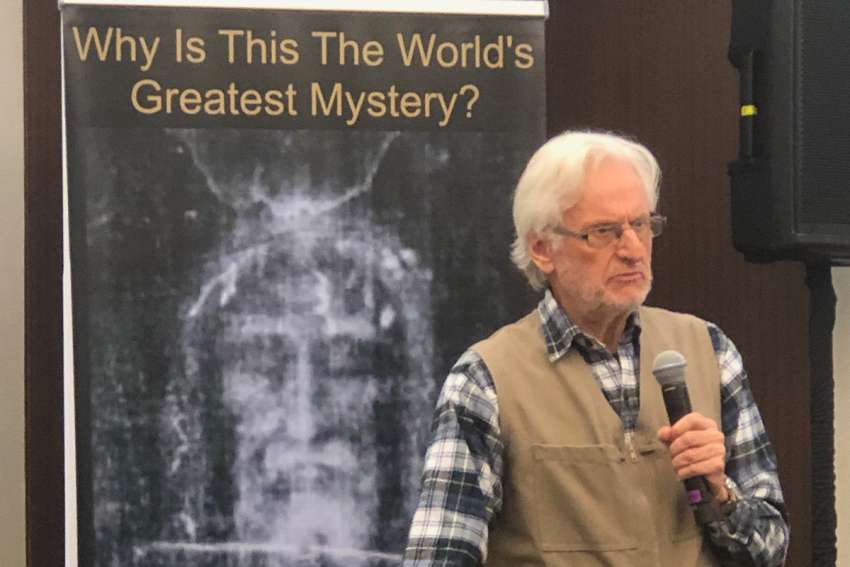WASHINGTON -- Are you looking to make an easy $1 million?
All you have to do is recreate a photographic negative image of an apparently crucified man on a 14-foot-by-3-foot piece of linen. And it has to have holographic features, so that when it is rendered as a three-dimensional profile based on the intensity of the shading, it should produce an accurately contoured 3-D image of a human form.
Oh, and — other than the linen, which will be provided — it all has to be done using only materials and methods that would have been available in medieval times, specifically between 1260 and 1390.
Maybe it’s not an easy million bucks after all.
That’s the challenge from David Rolfe, a British documentary film producer and researcher on the Shroud of Turin. He first announced the challenge to the British Museum in his 2022 documentary, Who Can He Be? The British Museum supervised a carbon-14 dating of the Shroud of Turin in 1988, with a few labs from around the world. That testing pronounced that the shroud was not the genuine burial cloth of Christ, as many believe, because the testing showed it to be produced in the 13th or 14th century.
However, since then, many researchers have noted that the testing was flawed. Rolfe notes that carbon dating was new at the time, with only seven labs in the world capable of the work.
The determination that the shroud had been created by a forger in medieval times meant that “the shroud went from hero to zero,” Rolfe said.
But Rolfe added that the sampling created several problems. Engravings from centuries past show people holding the shroud for display, clutching the corners. People want a closeness to holy relics, he said, and “the tighter you grip it, the more benefit you get.” This introduced medieval pollutants to the cloth. He said restorers were very good at fixing important cloths and tapestries, to the point of repairs being nearly invisible.
If, as museum officials said in 1988, some resourceful artist in the 1200s “faked it and flogged it off,” then Rolfe and other shroud enthusiasts claim it should be reproducible, including the unique characteristics that show the image of a man on the cloth does not contain any paint, ink, dye, stain or pigments, and that there is no image underneath the blood stains.
After almost two years of no response from the British Museum, the challenge is being extended to the United States by the National Shroud of Turin Exhibit, a group hoping to create a permanent museum space “in a city of museums” for a shroud replica and education, according to Myra Adams, executive director. The group currently has a mini-exhibit featuring an actual-size photographic replica of the shroud on display at the Catholic Information Center in Washington through the end of February.
The group announced the expanded challenge Feb. 8. Any person, organization or institution in the U.S. can apply to undertake the $1 Million Challenge to create the image. Up to three applicants will be accepted, each of which will receive three pieces of linen the same size as the shroud as the base for the recreation.
A donor who helped Rolfe finance his 2022 documentary agreed to put up the money for the prize. The same donor agreed to cover the U.S. prize, if anyone succeeds.
“He thinks his money is safe,” Rolfe said.
Rolfe and other shroud experts say the unique characteristics of the shroud are more clearly revealed through modern science. In recent decades, methods including 3-D scanning for relative density have been used to study the shroud.
“It keeps on revealing,” Rolfe said.
The prevailing theory is that an instantaneous burst of energy — possibly radiation — at the instant of the Resurrection, created the image on the shroud.
“The medium is energy. The image is not an additive process; it’s scorched,” Rolfe said.
He said that when the British Museum announced the carbon-14 results in 1988 and declared it to be a forgery, its scientists gave no indication that it was complex.
However, Rolfe and others such as Russ Breault, president of the Shroud of Turin Education Project, have looked at potential artists from the 14th century. They have found no art or artists from that time who worked with the kind of tools and techniques that could have created the shroud. And none of the extant artworks from that time period are done in the same style as that seen on the shroud, Breault said.
He added that forensic pathology shows wounds consistent with crucifixion, a practice the Romans ended in the 400s. And a recent archaeological find in Rome of a body that was crucified also shows similar wounds, including placement of the nails in the feet.
Rolfe said the judging process will be overseen by Paolo Di Lazzaro, a physicist who has studied the shroud. But he said, in some ways, “We don’t need a judge. The essential characteristics of the shroud,” including the depth of penetration of the image and other criteria, “are either right or wrong. It can’t be just something that looks like the shroud.”
Full details about can be found on the “Who Can He Be?”/Challenge site — https://whocanhebe.com/The_Challenge_2024.html.


